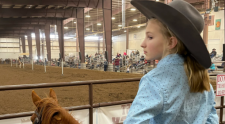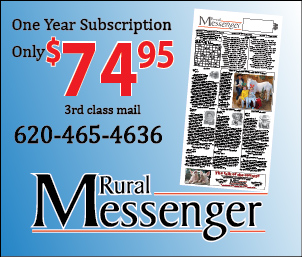As small town populations decline, people in places like western Kansas look for ways to keep their rural farming and ranching lifestyle alive for the next generation. Some families think youth rodeo might be part of the answer.
How do you turn kindergartners into wranglers?
“Little bitty saddles,” Melissa Vander Hamm said, “for little bitty kids.”
There’s a bit more to youth rodeo than that. You need your own horse. Plus a trailer to haul the horse and a truck to tow it all. To ride, you’ll need one of those little saddles and a bunch of other tack, which could put you back thousands of dollars.
In all, a youth rodeo family is an extensive, expensive commitment to living the rural Western lifestyle.
But Vander Hamm knows all that. She’s been competing in rodeo since she was nine years old. Her two sons started at age five. Now, she helps run the Young Guns Extravaganza, a youth rodeo series in Dodge City.
“It’s not a cheap hobby,” Vander Hamm said. “Drive through our parking lot on rodeo weekend and the amount of money just in pickups and trailers … it’s crazy.”
For rodeo families — most of whom, she said, come from agricultural backgrounds — the cost of competing is worth every penny as they look for ways to sustain their traditional way of life and their town’s population of young folks.
In a place where farms and ranches go back generations, rodeo is sewn deep into the cultural fabric of rural Kansas. But the number of people living in the region’s small towns has been shrinking for decades as young adults leave the rural life for bigger cities. Most counties in western Kansas have been steadily emptying since the Dust Bowl.
And parents like Vander Hamm, who lives in the neighboring town of Ingalls (population 288), hope that introducing more kids to the rodeo world might spur them to fall in love with their hometowns’ cowboy culture. Then maybe when those kids grow up, they’ll want to get back in the saddle again.
“The ones that do love it,” Vander Hamm said, “are inclined to come back and be part of the family farm.”
Despite any financial barriers to getting started, youth rodeo is growing.
Vander Hamm founded Young Guns in 2014 with a few other parents who wanted their kids to get more practice during the winter, when other competitions shut down.
The first year, she expected around 50 kids to show up. She got 120.
This season, Young Guns has welcomed nearly 400 little cowpokes into the arena, as they dummy rope, pole bend or barrel race their way to glory. And it’s just one of several youth rodeo associations across the state.
“I do think it’s a trend,” Vander Hamm said. “It’s a time when it’s cool to be a cowboy.”
Back in the saddle
On rodeo day, hundreds of horses trot through an expo center on the south edge of Dodge City. They kick up fine brown dust from the arena floor into clouds that hang in the air.
The morning starts with a prayer from the rodeo chaplain. Then comes the national anthem as the Miss Santa Fe Trail Queen gallops in with a flag.
Mesa Hedland stands near the arena entrance decked out in a brown Western shirt with leather tassels dangling from leopard print shoulder patches.
She’s waiting for her favorite event, which involves chasing down a goat and untying a ribbon from its tail, with help from her trusty steed named Ott.
“He’s addicted to me,” Hedland, who’s from Anthony, Kansas, said. “We can’t spend a day without hanging out with each other.”
Hedland is only five years old, but this is far from her first rodeo. She’s been chasing those goats since she was three.
In the horse warm-up area, nine-year-old friends Paisley Davis and Braylin Barratt offer a tour of the bridles and stirrups strapped to their four-hoofed friends. The pair live a few hours apart in southern Colorado, so they’re making up for lost time here.
Listening to them as they inspect their saddles and laugh about the odd things one particularly ravenous horse has eaten, it’s not hard to spot what rodeo families see as the upside of all this and what they hope kids take away from the experience.
The hard work it takes to care for an animal 10 times their size. The hours of practice required to master skills that most adults can’t pull off. The grit they need to ride into the arena — where every kid but one ends up leaving a loser.
“Be grateful that even though you didn’t win, someone else won,” Barratt said. “Always be grateful.”
And the bonds they form — with people and animals — along the way.
Davis walks up to her horse Thunder until the two stand eye-to-eye. She rests her hand on his neck near the black mane that she’s carefully woven into braids.
“When you do have a bad day,” Davis said, “you can just talk to your horse about it.”




